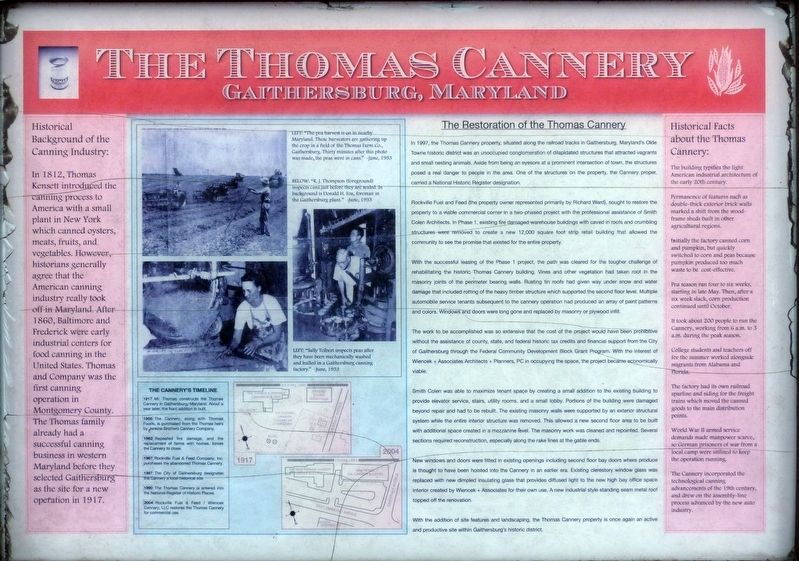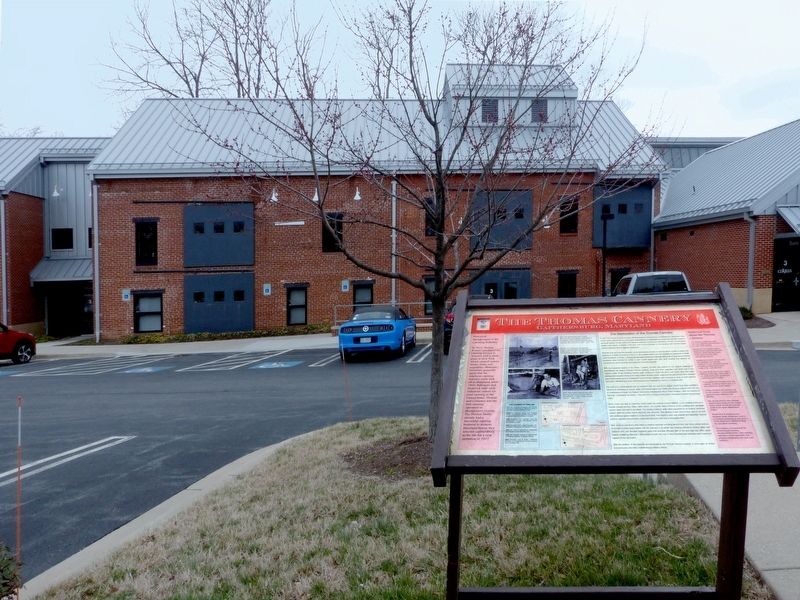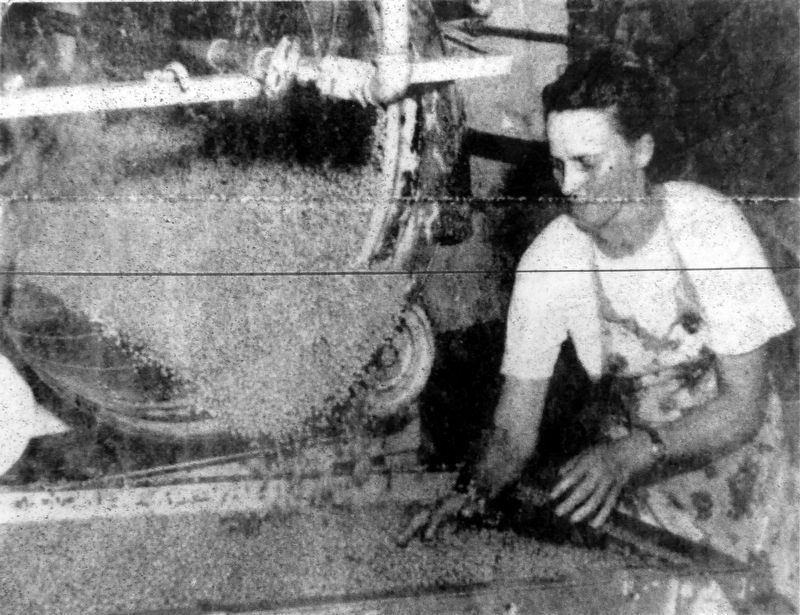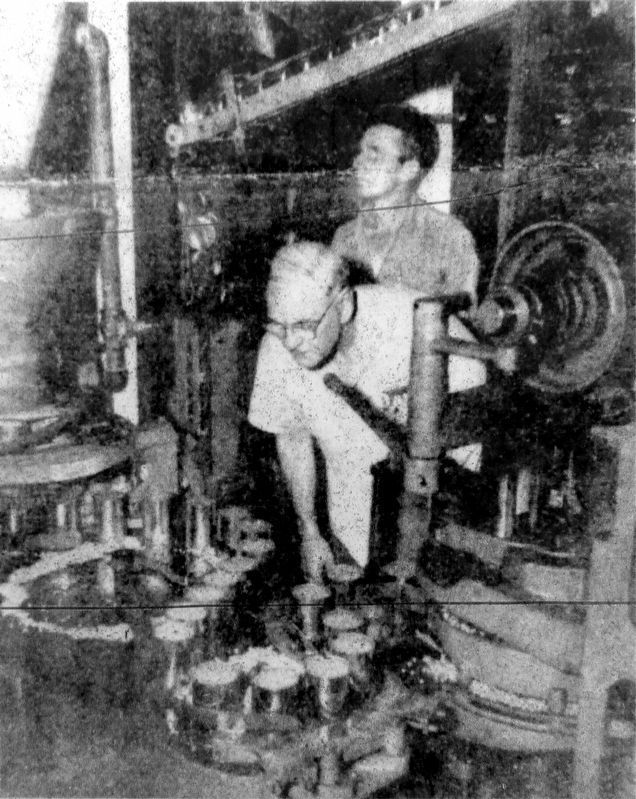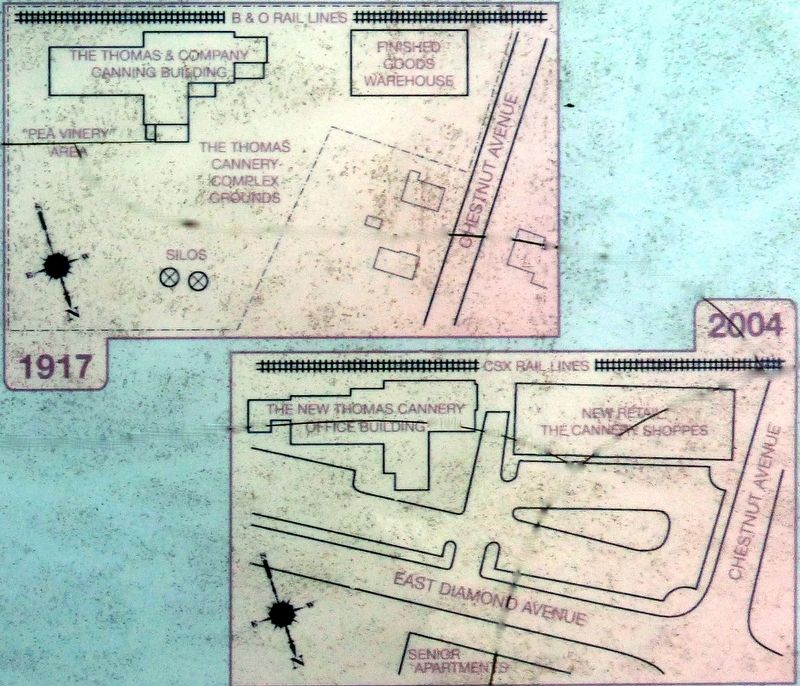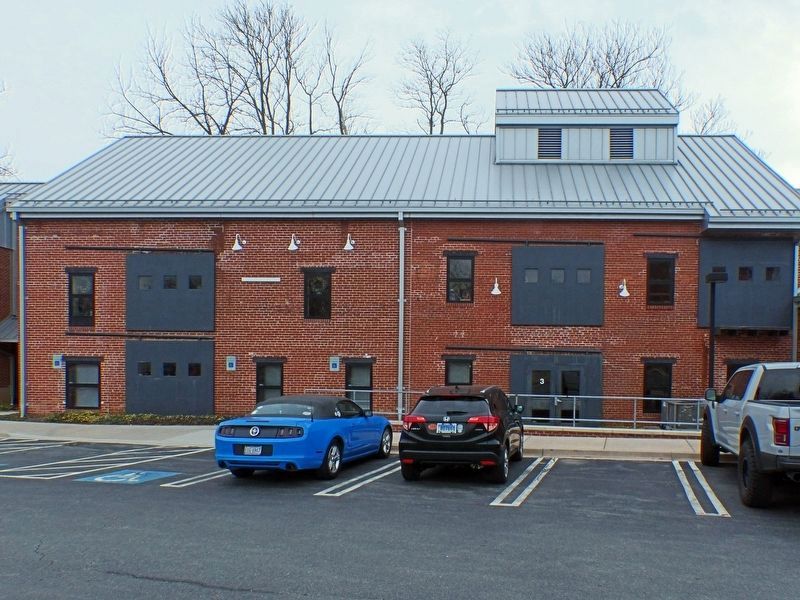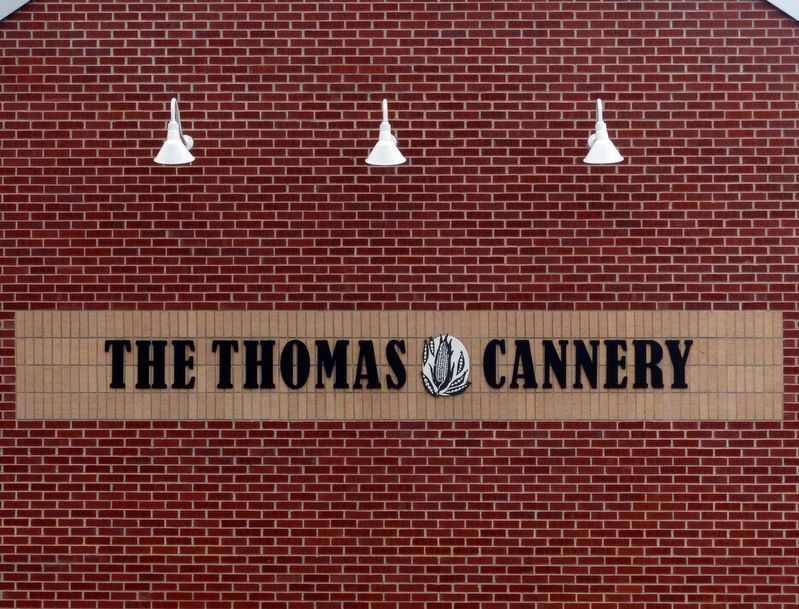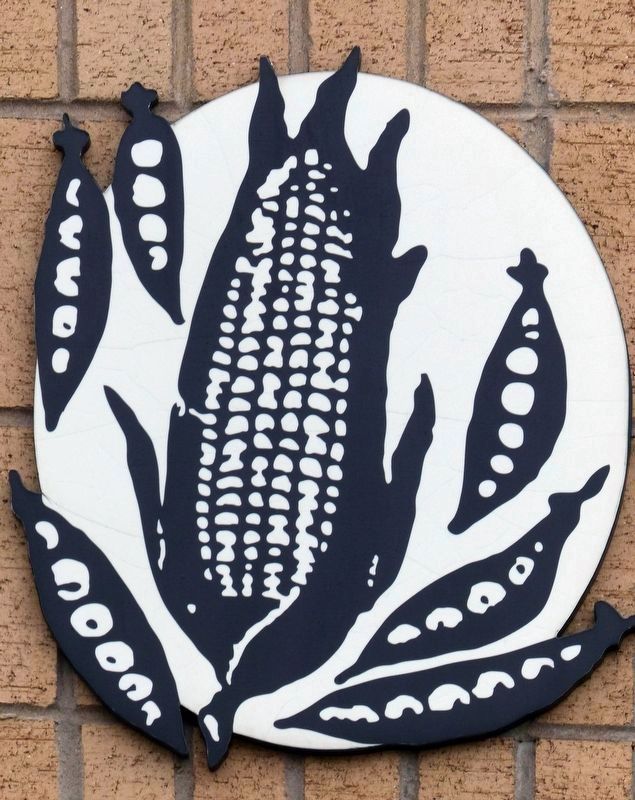Gaithersburg in Montgomery County, Maryland — The American Northeast (Mid-Atlantic)
The Thomas Cannery
Gaithersburg, Maryland
Historical Background of the Canning Industry:
In 1812, Thomas Kensett introduced the canning process to America with a small plant in New York, which canned oysters, meats, fruits, and vegetables. However, historians generally agree that the American canning industry really took off in Maryland. After 1860, Baltimore and Frederick were early industrial centers for food canning in the United States. Thomas and Company was the first canning operation in Montgomery County. The Thomas family already had a successful canning business in western Maryland before they selected Gaithersburg as the site for a new operation in 1917.
The Cannery's Time Line
1917 - Mr. Thomas constructs the Thomas Cannery in Gaithersburg. Maryland. About a year later the front addition is built.
1956 - The Cannery, along with Thomas Foods, is purchased from the Thomas heirs by Jenkins Brothers Cannery Company.
1962 - Repeated fire damage and the replacement of farms with homes, forces the Cannery to close.
1967 - Rockville Fuel & Feed Company, Inc. purchases the abandoned Thomas Cannery.
1987 - The City of Gaithersburg designates the cannery a local historical site.
1990 - The Thomas cannery is entered into the National Register of Historic Places.
2004 - Rockville Fuel & Feed / Wiencek Cannery, LLC restores the Thomas Cannery for commercial use.
The Restoration of the Thomas Cannery
In 1997, the Thomas Cannery property, situated along the railroad tracks in Gaithersburg, Maryland's Olde Towne historic district was an unoccupied conglomeration of dilapidated structures that attracted vagrants and small nesting animals. Aside from being an eyesore at a prominent intersection of town, the structures posed a real danger to people in the area. One of the structures on the property, the Cannery proper carried a National Historic Register' designation.
Rockville Fuel and feed (the property owner represented primarily by Richard Ward), sought to restore the property to a viable commercial corner in a two-phased project with the professional assistance of Smith Colen Architects: In Phase 1, existing fire damaged Warehouse buildings with caved-in roofs and crumbling structures were removed to create a new 12,000 square foot strip retail building that allowed the community to see the promise that existed for the entire property.
With the, successful leasing of the Phase 1 project, the path was cleared for the tougher challenge of rehabilitating the historic Thomas Cannery building. Vines and other vegetation had taken root in the masonry joints of the perimeter bearing walls. Rusting tin roofs had given way under snow and water damage that included rotting of the heavy timber structure which supported the second floor level. Multiple automobile service tenants subsequent to the cannery operation had produced an array of paint patterns and colors. Windows and doors were, long gone and replaced by masonry or plywood infill.
The work to be accomplished was so extensive that the cost of the project would have been prohibitive without the assistance of county, state, and federal historic tax credits and financial support from the City of Gaithersburg through the Federal Community Development Block Grant Program. With the interest of Wiencek + Associates Architects + Planners, PC in occupying the space, the project became economically viable.
Smith Colen was able to maximize tenant space by creating a small addition to the existing building to provide elevator service, stairs, utility rooms, and a small lobby. Portions of the building were damaged beyond repair and had to be rebuilt. The existing masonry walls were supported by an exterior structural system While the entire interior structure was removed. This allowed a new second floor area to be built with additional space created in a mezzanine level. The masonry work was cleaned and repointed. Several sections required reconstruction, especially along the rake lines at the gable ends.
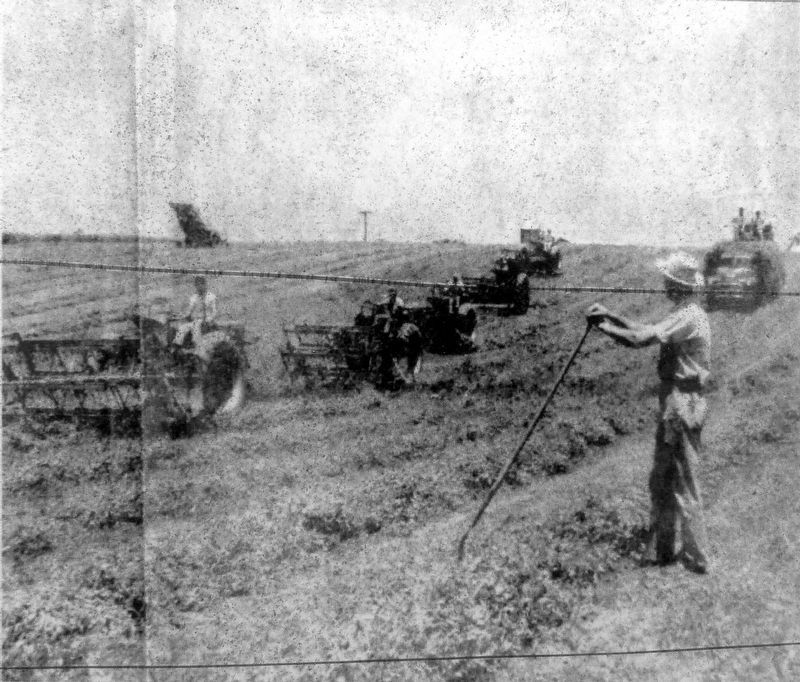
Photographed By Allen C. Browne, March 6, 2017
3. Pea Harvest
“The pea harvest is on in nearby Maryland. These harvesters are gathering up the crop in a field of the Thomas Farm Co., Gaithersburg, Thirty minutes after this photo was made, the peas were in cans." — Washington Times-Herald, June 8 1953Close-up of photo on marker
New windows, and door's were fitted in existing openings including second floor bay doors where produce is thought to have been hoisted into the Cannery in an ear1ier era: Existing clerestory Window glass was replaced with new dimpled insulating glass that provides diffused light to the new high bay office space interior created by Wiencek + Associates for their own use. A new industrial style standing seam metal roof topped off the renovation.
With the addition of site features and landscaping, the Thomas Cannery property is once again an active and productive site within Gaithersburg's historic district.
Historical Facts about the Thomas Cannery
The building typifies the light American industrial architecture of the early 20th century.
Permanence of features such as double-thick exterior brick walls marked a shift from the wood frame sheds built in other agricultural regions.
Initially the factory canned corn and pumpkin, but quickly switched to corn and peas because pumpkin produced too much waste to be cost-effective;
Pea season ran four to six weeks, starting in late May. Then, after a six week slack, corn production continued until October.
It took about 200 people to run the Cannery, working from 6 a.m. to 3 a.m. during the peak season.
College students and
teachers off for the summer worked alongside migrants from Alabama and Florida.
The factory had its own railroad spur line and siding for the freight trains which moved the canned goods to the main distribution points.
World War II armed service demands made manpower scarce so German prisoners of war from a local camp were utilized to keep the operation running.
The cannery incorporated the technological canning advancements of the 19th century, and drew on the assembly-line process advanced by the new auto industry.
Topics. This historical marker is listed in these topic lists: Architecture • Industry & Commerce • Notable Buildings.
Location. 39° 8.537′ N, 77° 12.099′ W. Marker is in Gaithersburg, Maryland, in Montgomery County. Marker is on East Diamond Avenue, 0.4 miles west of North Frederick Avenue (Maryland Route 355), on the right when traveling east. Touch for map. Marker is at or near this postal address: 3 East Diamond Avenue, Gaithersburg MD 20877, United States of America. Touch for directions.
Other nearby markers. At least 8 other markers are within walking distance of this marker. Chestnut/Meem Historic District (about 700 feet away, measured in a direct line); Brookes, Russell and Walker Historic District (approx. 0.3 miles away); The Gaithersburg Wye (approx. 0.3 miles away); DNC Building (approx.
0.4 miles away); The Chandler Wobble (approx. 0.4 miles away); The Observatory (approx. 0.4 miles away); History and Purpose of the Gaithersburg Latitude Observatory (approx. 0.4 miles away); John A. Belt Building (approx. 0.4 miles away). Touch for a list and map of all markers in Gaithersburg.
Also see . . . Thomas & Company Cannery. Maryland Historical Trust (Submitted on March 8, 2017, by Allen C. Browne of Silver Spring, Maryland.)
Credits. This page was last revised on September 22, 2019. It was originally submitted on March 7, 2017, by Allen C. Browne of Silver Spring, Maryland. This page has been viewed 738 times since then and 72 times this year. Last updated on March 9, 2017, by Allen C. Browne of Silver Spring, Maryland. Photos: 1, 2, 3, 4, 5, 6. submitted on March 7, 2017, by Allen C. Browne of Silver Spring, Maryland. 7, 8, 9. submitted on March 9, 2017, by Allen C. Browne of Silver Spring, Maryland. • Bill Pfingsten was the editor who published this page.
